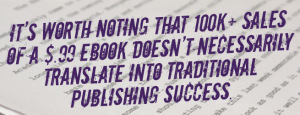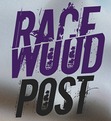Publishers Take Note
 he traditional publishing industry has a lot to learn if they hope to survive the next ten years. Like the music, movie and t.v. industry before them, publishers are going to have to move into the 21st century and embrace ebooks rather than continue to fear them.
he traditional publishing industry has a lot to learn if they hope to survive the next ten years. Like the music, movie and t.v. industry before them, publishers are going to have to move into the 21st century and embrace ebooks rather than continue to fear them.
Depending on who you ask, the 50 Shades phenomenon was sort of a knee-jerk reaction by the traditional publishing industry in response to the sudden popularity of the $.99 ebook crazy that has taken over in traditional publishing. And if that’s the case, I’m a little more sympathetic to their plight. The problem is, publishing a book that really should have stayed in the self publishing world (as one of the many we weren’t exactly proud of) isn’t the answer. Sure it’s brought them a great amount of success but at what cost? Here’s what the publishing industry needs to understand first and foremost. 
Printed books aren’t going anywhere, because bibliophiles wouldn’t stand for it. There many not be many of us left in the world, or even in America, but as long as lovers of books still remain, the printed word will never be gone. I love ebooks, a lot more than I ever thought I would, but there’s something about having a full library and holding a book in your hand that you can’t replicate with an ebook, no matter how hard Apple tries. And as far as readers are concerned, one of the lessons I’ve learned from the process of self publishing is that the smart readers will always buy a first edition hardback because (particularly if it’s signed) it’ll be worth something later (assuming the author is famous or becomes famous) not to mention, it’s far more valuable sentimentally.
Second publishers need to realize that while self publishing has taken off considerably, there are still many authors who wish to seek traditional representation. I seriously doubt that will change.
It’s also worth noting that 100k plus sales of a $.99 ebook doesn’t necessarily translate into traditional publishing success. This is a lesson publishers are starting to find out the hard way. Traditional publishers are offering self published authors who sold a large number of books on their own 6 and 7 figure book deals, the problem is, just because you can sell 100k or more of a book that’s a dollar, doesn’t necessarily mean that people will want to buy it when it’s $10. Stories of this success would have you believe that selling a 100k in a year is pretty easy. Especially at $.99, but with hundreds of new books being self published every day, it’s not as easy as it sounds, but just because a few have been lucky enough to make it, doesn’t necessarily mean that such a story will be able to continue to have commercial success.
I think one of the biggest lessons the traditional publishing industry is going to have to eventually learn is that the ebook version of a novel can’t be the same price as the print model. It just can’t, there’s nothing particularly special about 99% of ebooks that cost the exact same amount as their print counterparts and considering how easy it is to make an ebook file that looks just as good as an ebook. (Kindle offers a special InDesign plugin. I’m sure others offer the same for larger publishing houses). It’s not that difficult.
The traditional publishing industry doesn’t have to collapse in on itself, if they can learn the lessons of other companies, and move into the future, they can continue to thrive. Or, they can fear the future, and keep publishing 50 Shades knockoffs. The choice is theirs. And sadly I highly doubt their going to take the advice of a 21 year old self published, virtually unknown, author.






